The pest season is beginning to pick up. It is time to be scouting to see if you are one of the lucky growers.
In this issue:
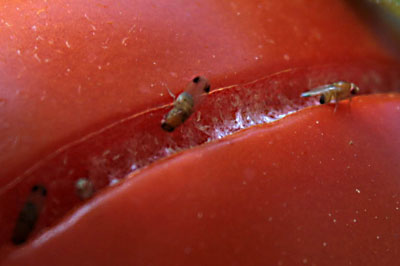 |
| Close-up of spotted wing drosophila on a tomato |
Spotted Wing Drosophila
Black Leg in Potatoes
Potato Leaf Hopper on Beans and Potatoes
Powdery Mildew in Cucurbit Crops
SPOTTED WING DROSOPHILA UPDATE
Spotted wing drosophila captures are becoming more widespread this week, although numbers are still quite low. Single female flies were caught in traps in Cape Elizabeth, Buxton, Turner and Wales this week. We also have reports of flies being caught in New Hampshire, Connecticut and New York, but also in relatively low numbers.
We expect populations to start to build rapidly in the coming weeks as more food (fruit) becomes available for the flies, especially if conditions remain warm and humid. Now is the time to set out traps, if you haven’t already. Start protective sprays on any berries that have begun to ripen once more than one spotted wing drosophila is caught in a trap, or any larvae are noticed in the fruit. Look for fruit flies hovering around fruit and symptoms of premature fruit decay.
Last year, populations did not reach damaging levels until late August; but weather conditions can alter how quickly the flies will build up. Keeping the fields clean of over-ripe and rotten fruit can also help reduce the incidence of this insect.
There is a good fact sheet series on management of spotted wing drosophila from Penn State Extension.
Reprinted from University of Maine Cooperative Extension
David Handley, Vegetable & Small Fruit Specialist; James Dill, Pest Management Specialist; Frank Drummond, Professor of Insect Ecology/Entomology
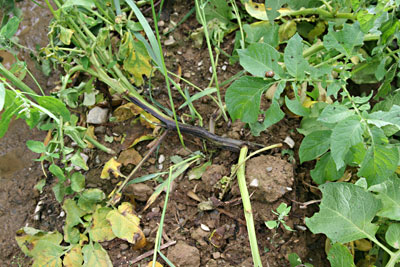 |
| Black leg on potato |
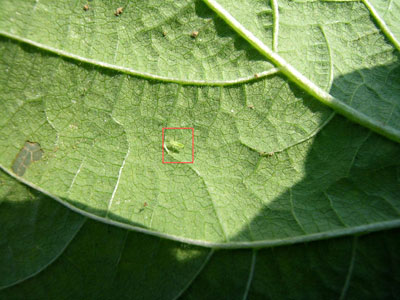 |
| Leafhopper nymph close-up (in the red square) |
I have received a few calls from folks thinking they have late blight who actually have black leg. Late blight has been found at only one site at this time. Black leg is caused by the same bacteria that causes soft rot of potatoes. Potato seed is often the source of the bacteria, but it is the weather that is the main factor. When it gets too wet the soil becomes waterlogged and these bacteria are favored.
Potato Leafhoppers (PLH) have made it to Maine. They are in big numbers in some fields, which may be very bad news. They are likely to be moving north so be on the lookout. They primarily feed on beans, potatoes, eggplants, strawberries and alfalfa. PLH do not overwinter anywhere near here. They overwinter way down south and leapfrog up here in mass migrations. The first to arrive are females, and they are usually carrying fertilized eggs when they get here. Then there are a few generations over the growing season before the cold north winterkills them.
The damage from leafhopper is catastrophic. The bug sucks the juice out of the plant and injects a toxin that clogs the food conducting tissue. The symptoms look like a disease after a while, rather than insect damage, and is frequently mistaken as such. The leaves first get pale, then yellow and then brown from the edges. Then the plant dies. The symptoms are called hopper burn.
The adult PLH is very light green and wedge shaped and tiny (an eighth of an inch long). The best way to find them is to brush the plant and watch one of the white-looking bugs land. The nymphs are similar to the adult, but have no wings and are even smaller and live on the underside of the leaves. If you disturb a nymph you will see it run and it can run sideways as fast as forward. This is a clue that you have PLH and not some other less harmful leafhopper.
The adults are flighty. When you brush your crop you will see them fly up. If there is a cloud of them, you are in trouble.
Researchers have developed a threshold before treatment is recommended. Thresholds vary but here is one that is typical: Treat potatoes if 5 adults or 15 large larvae are found on 50 leaves.
Crop rotation does nothing for you since they are coming from far away. Covering your crops with a row cover would work, but these crops are not the type that is usually covered. Effective insecticides are limited. The only material that I have seen work that is allowed in organic production is pyrethrum, so Pyganic is the recommendation that I make. However, it does not work as well as a pyrethrum with PBO, BUT PBO is not permitted in organic production. If you market crops as organic, be sure to use an approved brand. Use the most concentrated mix allowed. Spray late in the day or evening, get good coverage including the undersides of the leaves, and don’t wait until it is too late.
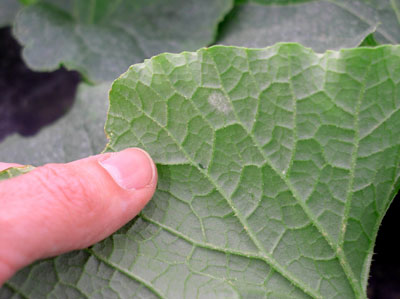 |
| Powdery mildew on the underside of a leaf |
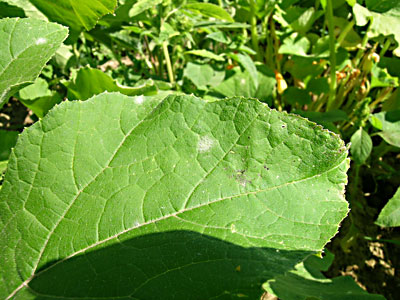 |
| Powdery mildew on the top surface of a pumpkin leaf |
Powdery mildew is a common disease of pumpkins and winter squash. All cucurbits are susceptible, but many common cucumber and melon varieties are resistant. The disease can cause infected leaves to die prematurely, reducing yields and lowering fruit quality, especially taste. Winter squash from diseased plants won’t store as long as fruits from healthy plants. The fungus that causes the disease does not overwinter in Maine. Spores blow up every year from southern overwintering sites. If they arrive late in the season, you may not need any control; but if they arrive in early to midsummer, exercise some control or you may have no leaves by mid-August, or bland starchy squash.
I have not seen any yet, but have heard of some. This may warrant attention. Go out and scout. Check upper and lower surfaces of leaves of older plants every few days starting now. The first symptoms usually are white, powdery fungal patches on the undersides of older leaves. Yellow spots may form opposite these, on the upper leaf surfaces.
No products with systemic activity (products that move through the plant) are approved for organic production, and applying fungicide to the lower leaf surface is difficult. In experiments, foliar applications of sulfur have been more effective than most other organic products for powdery mildew, apparently because sulfur deposited on the upper leaf surface can volatilize and be redistributed to the lower surface. Sulfur can be phytotoxic on melons, especially if applied when temperatures are hot.
There are some new products made from potassium bicarbonate (Kaligreen and Milstop are two of these) that are showing good efficacy. For a good discussion of these, including efficacy, see the new edition of the Resource Guide to Organic Insect and Disease Management.
ATTRA (National Sustainable Agriculture Information Service) reports that a single spray application (to runoff) of 0.5 percent (wt./vol. of water) baking soda, plus 0.5 percent (vol./vol. of water) SunSpray UFP® horticultural oil almost completely inhibited powdery mildew on heavily infected pumpkin foliage; while baking soda without the oil was ineffective, and a 2 percent (wt./vol. of water) solution of baking soda damaged the leaves.
